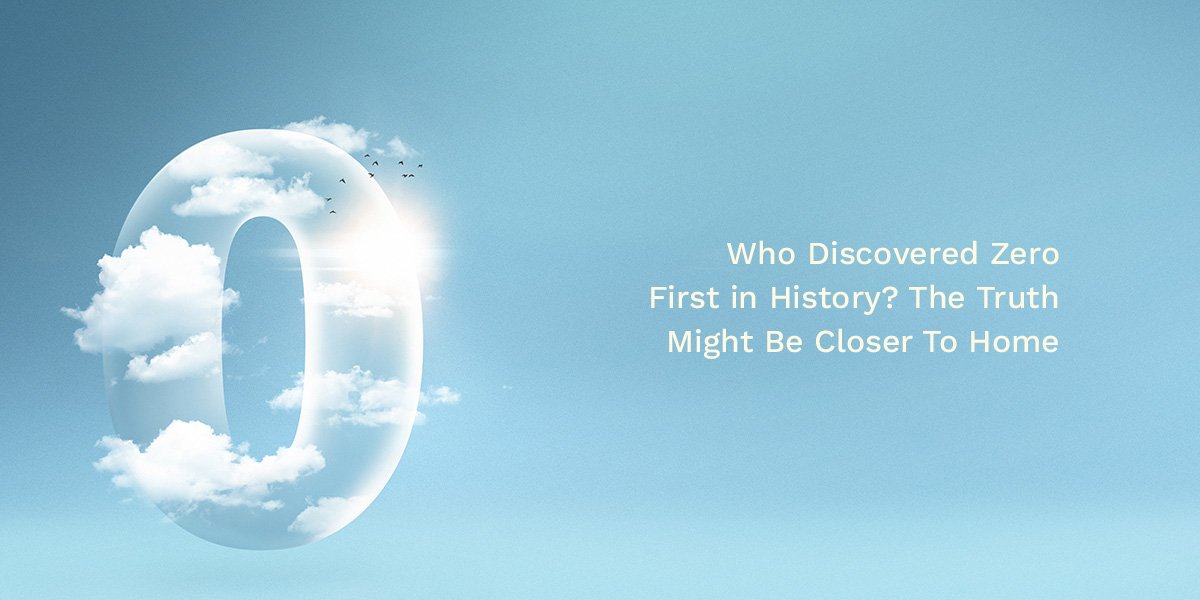- Sakal India Foundation
- March 20, 2023
Table of Contents
What Is The Origin Of Zero In India
The concept of zero has been independently discovered and developed by many ancient civilizations, including the Mayans, Babylonians, Indians, and Chinese. However, the credit for the discovery of the number zero as a numerical digit is generally attributed to the ancient Indian mathematicians.
The Indian mathematicians initially used a dot or a small circle to represent zero, and the first recorded use of the digit zero as a placeholder in positional notation (i.e., as the symbol for an empty place in a numeral) dates back to the 7th century CE, in Indian mathematical texts known as the Brahmasphutasiddhanta and the Khmer numerals.
Later, the concept of zero was introduced to the Arab world by Indian mathematicians and scholars, and it spread to Europe through the works of Arab mathematicians such as Al-Khwarizmi and Al-Kindi during the Middle Ages.
Therefore, while the exact origins of the concept of zero remain unclear, it is generally accepted that the ancient Indian mathematicians played a crucial role in developing the concept and introducing it to the world.
Who Invented ZERO & Why?
The concept of zero as a number and a mathematical digit was invented independently by different civilizations, including the ancient Babylonians, Mayans, and Indians. However, it was the Indian mathematician and astronomer, Brahmagupta, who is widely credited with introducing the concept of zero as a number and a mathematical digit in its own right.
Brahmagupta lived in India during the 7th century AD and is considered one of the most influential mathematicians of the time. He wrote several works on mathematics and astronomy, including the Brahmasphutasiddhanta, which contained the earliest known explicit treatment of zero as a number.
Brahmagupta recognized zero as a placeholder, which allowed for the creation of the decimal system and made calculations much easier. He also developed rules for arithmetic operations involving zero, such as the idea that any number multiplied by zero is zero.
The concept of zero was revolutionary in mathematics and had a significant impact on fields such as algebra, calculus, and computer science. It allowed for the development of advanced mathematical concepts and calculations, which would have been impossible without it.
Development of Zero in India
The development of zero in India was a gradual process that spanned several centuries. The concept of zero as a placeholder first appeared in the Indian mathematical texts during the Gupta period (4th to 6th century AD). Initially, zero was used only as a placeholder to indicate the absence of a digit in a numerical system based on the Brahmi script.
However, by the 7th century AD, Indian mathematicians began to treat zero as a number in its own right. The Indian mathematician and astronomer Brahmagupta (598-668 AD) was one of the first to recognize the importance of zero. He wrote extensively on the subject, including the Brahmasphutasiddhanta, which contained the earliest known explicit treatment of zero as a number.
Brahmagupta recognized zero as a powerful tool for mathematical calculations, allowing for the creation of the decimal system and simplifying arithmetic operations. He also developed rules for arithmetic operations involving zero, such as the idea that any number multiplied by zero is zero.
The Indian mathematician and astronomer Aryabhata (476-550 AD) also made important contributions to the development of zero. He used zero in his astronomical calculations, and his work paved the way for the use of zero in calculus and other advanced mathematical concepts.
The development of zero in India was a key factor in the spread of mathematics throughout the world. Arab traders and scholars brought Indian mathematics, including the concept of zero, to the Islamic world in the 8th century AD. From there, it spread to Europe, where it revolutionized mathematics and science.
History of math and zero in India
The history of math and zero in India dates back to ancient times. The earliest evidence of Indian mathematics can be traced back to the Indus Valley Civilization, which existed between 2600 BCE and 1900 BCE. The people of this civilization used a decimal system of counting and measurement, which was based on the number ten.
However, the concept of zero as a number and a mathematical digit developed later in India. Initially, zero was used only as a placeholder to indicate the absence of a digit in a numerical system based on the Brahmi script. This system was used in India during the 3rd century BCE.
The development of zero as a number in its own right is attributed to the Indian mathematician and astronomer Brahmagupta (598-668 AD). He recognized zero as a powerful tool for mathematical calculations, allowing for the creation of the decimal system and simplifying arithmetic operations. He also developed rules for arithmetic operations involving zero, such as the idea that any number multiplied by zero is zero.
The Indian mathematician and astronomer Aryabhata (476-550 AD) also made important contributions to the development of zero. He used zero in his astronomical calculations, and his work paved the way for the use of zero in calculus and other advanced mathematical concepts.
The concept of zero was revolutionary in mathematics and had a significant impact on fields such as algebra, calculus, and computer science. It allowed for the development of advanced mathematical concepts and calculations, which would have been impossible without it.
The development of zero in India was a key factor in the spread of mathematics throughout the world. Arab traders and scholars brought Indian mathematics, including the concept of zero, to the Islamic world in the 8th century AD. From there, it spread to Europe, where it revolutionized mathematics and science.
Arabic and Persian Influence
Arabic and Persian have had significant cultural, linguistic, and historical influences in various regions of the world. Here are some of the major impacts of Arabic and Persian culture:
- Language: Arabic and Persian are two of the most widely spoken languages in the Middle East and Central Asia. Both languages have heavily influenced many other languages, including Turkish, Urdu, and Kurdish, among others.
- Literature: Arabic and Persian literature have had a significant impact on world literature. The works of Rumi, Hafez, and Omar Khayyam are widely read and celebrated around the world.
- Science and mathematics: Many Arabic and Persian scholars have contributed significantly to the fields of science and mathematics, including al-Khwarizmi, Ibn al-Haytham, and al-Ghazali.
- Art and architecture: Islamic art and architecture, heavily influenced by Arabic and Persian styles, are some of the most beautiful and unique in the world. Examples include the Alhambra in Spain, the Taj Mahal in India, and the Blue Mosque in Istanbul.
- Religion: Islam, which has its roots in Arabia, has spread throughout the world and has become one of the major religions. Persian mysticism, especially Sufism, has also had a significant impact on Islamic spirituality.
Overall, Arabic and Persian cultures have played an essential role in shaping the world’s cultural, linguistic, and religious landscape, and their influences can still be seen today.
European Acceptance and Further Developments
The influences of Arabic and Persian cultures on Europe have been significant and far-reaching. Here are some of the ways that European societies have accepted and further developed Arabic and Persian influences:
Science and philosophy: During the Islamic Golden Age (8th-13th centuries), Arab and Persian scholars made significant contributions to mathematics, astronomy, medicine, and philosophy. Their works were translated into Latin and other European languages and studied by European scholars during the Renaissance.
Art and architecture: European art and architecture were heavily influenced by Islamic art and architecture, which incorporated intricate geometric patterns and calligraphy. Examples of this influence can be seen in the Alhambra in Spain and the mosques of Istanbul.
Music: The Arabic musical tradition influenced European classical music, especially during the Renaissance. Many composers, such as Johann Sebastian Bach, were inspired by the melodic and rhythmic structures of Arabic music.
Literature: The works of Arabic and Persian poets, such as Rumi and Hafez, have been translated into European languages and are widely read and admired. These works have influenced European literature and poetry, and their themes of love, spirituality, and nature continue to resonate with readers.
Food: Many European cuisines have been influenced by Arabic and Persian culinary traditions, such as the use of spices, herbs, and cooking methods.
Overall, the acceptance and further development of Arabic and Persian influences in Europe have enriched European culture, art, science, and philosophy, and their impacts can still be seen today.
The modern form
The modern form of zero is a numerical digit that represents the absence of a value or quantity, or a placeholder in the positional notation system used in modern mathematics. The concept of zero as a number was first developed in ancient India, and it gradually spread to other parts of the world, including the Islamic world and Europe. The modern decimal system, which uses zero as a placeholder, was developed in India in the 5th century CE and later spread to the Arab world and Europe. Today, zero is a fundamental concept in mathematics and plays a critical role in many areas of science, technology, and engineering.
The last phase of the journey of Zero
The last phase of the journey of zero refers to its widespread acceptance and adoption as a fundamental concept in mathematics and its use in various fields. Zero was first used as a number and placeholder in ancient India around 500 CE, and it gradually spread to the Arab world and Europe over the next few centuries. However, it wasn’t until the Renaissance and the development of modern mathematics that zero became widely accepted and used. In the 17th century, the use of zero became more widespread with the development of calculus by mathematicians such as Isaac Newton and Gottfried Leibniz, which relied heavily on the concept of zero.
Today, zero is a fundamental concept in mathematics and is used extensively in many fields, including science, technology, engineering, and economics. Its applications range from simple arithmetic operations to complex algorithms used in computer science and artificial intelligence. The journey of zero from its origin in ancient India to its widespread use today is a testament to the power of human knowledge and innovation.
Conclusion
In conclusion, zero is a fundamental concept in mathematics that has played a crucial role in the development of modern science, technology, and engineering. Its journey from its origin in ancient India to its widespread acceptance and use today is a testament to the power of human innovation and knowledge. Zero’s use as a number and placeholder has allowed for the development of complex mathematical systems and has enabled the creation of new technologies that have transformed the world we live in. As we continue to explore and push the boundaries of human knowledge and understanding, zero will undoubtedly continue to play a critical role in shaping our future.








Post a Comment